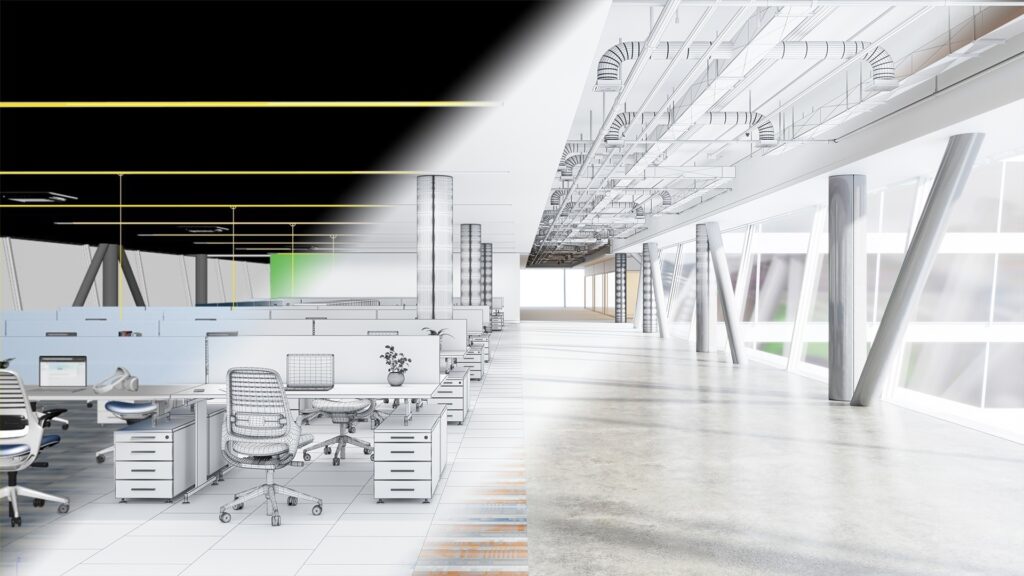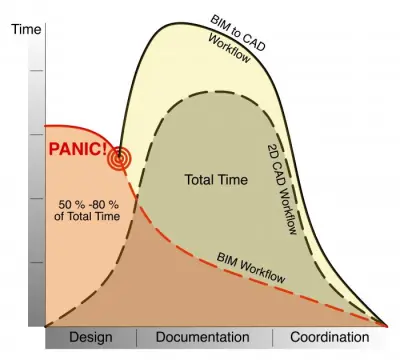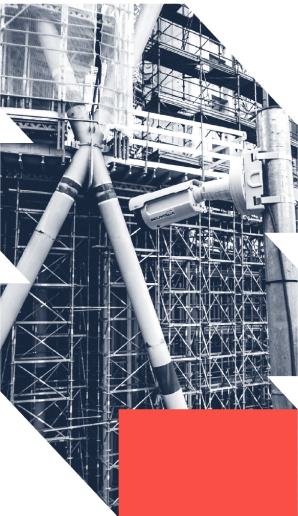BIM Design Using Agile Scrum Methodology

The assumed project production process
At least since the beginning of the Industrial Era, a project’s conception and development in the AEC industry have been executed in a Waterfall-like fashion, meaning that it is developed in an explicit and planned set of sequential steps.
As such, in a more traditional workflow, the inflexibility of a waterfall project management style tends to be one of the biggest problems during the development of a Project. Once the project is in the later stages it becomes hard and expensive to make changes to the design, then, it means that the Cost Estimation tasks, documentation updates, and even Energy Analysis, will have to be redone to comply with the new changes. This might help a lot for planning and predictability, but as we said, it frequently causes high costs on reviews.
In construction, there have been good initiatives of bringing the Agile concept to optimize the processes within the development of a project (from multiple flanks, such as logistics, human and material resources, project management, and fabrication, among others).
One of these initiatives worth mentioning has been Lean Construction, which aims to improve processes that impact the built and natural environment, focusing on the complete lifecycle of a project.
Today, we want to discuss the possibility of bringing to the BIM/Design phase one of the most ubiquitous software development tools. The scrum methodologies.
Scrum is an agile methodology that allows its users to get an understandable project quickly and handle uncertainty, while continuously keeping delivering value.
What is an Agile Scrum Methodology?
Agile is an idea that allows us to be able to react (in a proactive way) to changes in our environment and develop the best solutions dynamically to these changes. Inside Agile, we can find multiple frameworks that ground this idea and lets us execute on it.
SCRUM framework is very present in the Tech industry, as it allows them to produce better software in a more precise way by making progressive deliveries of the product and keep iterating over the feedback.
Maybe you are wondering exactly how we can get quick feedback and handle uncertainty from the very beginning of a project, right?
By using SCRUM it is possible to achieve better results by getting the most fundamental elements that will allow the team in charge of the project to analyze the possible outcomes and make better decisions based on those analyses.
The team will take this fundamental state of the project and keep iterating over it, adding more specificity and detail, giving a more precise perception and understanding of the project overall.
These iterations are known as “sprints” within the SCRUM methodology.
Agile Framework for Effective Collaboration
Here’s a concise explanation of Scrum:
Core Principles: Scrum is based on a set of core principles:
- Iterative Development: Projects are broken into small, manageable parts called “sprints.” Each sprint typically lasts two to four weeks, during which a potentially shippable product increment is created.
- Empowered Teams: Cross-functional teams are self-organizing and have the authority to make decisions. They collaborate closely to deliver high-quality work.
- Continuous Improvement: Regular reflection and adaptation are encouraged. After each sprint, teams hold a retrospective to identify areas for improvement.
Key Roles: Scrum defines three primary roles:
- Product Owner: This role represents the customer or stakeholder and is responsible for prioritizing work, defining requirements, and ensuring that the team delivers value.
- Scrum Master: The Scrum Master acts as a servant-leader, facilitating the Scrum process, removing obstacles, and coaching the team to improve.
- Development Team: The team comprises professionals responsible for delivering the product increment. They collaborate to design, develop, and test the product.
Artifacts: Scrum uses specific artifacts to manage work:
- Product Backlog: A prioritized list of all work items or features needed for the project.
- Sprint Backlog: A subset of the product backlog selected for the current sprint.
- Increment: The portion of the product completed during a sprint.
Benefits: Scrum provides several advantages, including faster time-to-market, increased customer satisfaction, and enhanced team collaboration. It promotes adaptability and transparency, allowing teams to respond to changing requirements effectively.
The Anatomy of the Scrum methodology in the BIM process
Imagine your team starting a project by defining the scope, available references, getting notes of relevant regulations, and previous projects. This stage can be defined as Sprint Zero, where the team starts preparing.
After defining what is going to be the main milestone, the team defines the tasks to do on a board called Backlog. ****
Then, they define a frequency of deliveries and reviews, which are called Sprints, where you can stop and asses the effort made and the results, which is the Sprint Review.
Then, after a sprint is done, you will start a new one by selecting the tasks to be done before starting, which would be the Sprint Planning.
When the Sprint is done, apart from the Sprint Review, which is a quantitative analysis, you and your team analyze what went well, and what to improve Retrospective, which is qualitative.
As you see, you are probably doing one or two of these ceremonies in your current work. Why not to extend them with a very clear objective?

Architectural Visualization in the AEC Industry
Scrum is a way of working that is widespread in the Software industry, but also in Graphic Design and Architectural Visualization (Archviz), the latter being inside of the AEC industry as well.
In the case of Archviz, we can see how the artist constantly iterates over his work based on continuous deliveries and executes on feedback from the client, each round of feedback/analysis will get the product (or the image/render in this case) closer to its final form.

Set the Design free!
Just to make it clear, in this particular article we are not making a critique of the Waterfall project management style across all the development of a building but on the Design stage. This is because so far it does not seem to be a way to iteratively build a building, and we are not precisely sure if we want to explore that, as the execution of a building must be a very precise and careful endeavor.
We propose a way of letting a project grow and be incrementally improved over an existing and already functional basis. This means that we want to get quickly to a stage of the project where we can start obtaining rough reports on Cost Estimations and Energy Analysis, and after each time we execute an iteration of the project we can see updated reports and metrics on how well the project is or will perform financially and in a matter of energy efficiency (or even real-time as the project is being developed)
But, how can we get reports on this after weekly or bi-weekly iterations, or real-time, without driving crazy a team of estimators following to the millimeter whatever happens in the project and performing the analysis on it?
We can automate these reports and data extractions from a BIM model, this is where we say that it is extremely important for the AEC industry to start borrowing some of the practices and workflows we can see in the Software industry, and make our processes much more efficient.
We can leverage software that adapts to our processes, and start automating all the repetitive tasks that follow a very clear pattern or are not essentially creative.
BIM has been around for 20+ years now, but overall we still have not been able of grasping the benefits of the gold-mine of data that a well-developed BIM model can be, it can have all the information we need to automate the following tasks:
- Cost Estimation
- Energy Analysis
- Quality Assurance
- Level of Information
- Documentation (Tagging, dimensioning, placing views on sheets, …)
- Getting summarized reports/dashboards following the principles of Data Visualization
- and much more…
A BIM model is a huge database that coincidentally has a 3D representation of itself in the shape of a building.
With all of this, we are bringing the majority of iterations and decision-making from the construction site to the Design team, therefore, increasing the Design time, but reducing the construction and coordination efforts, which currently are the stages where most of the rework is done.

An invitation to become a better industry managing BIM projects
The next time you are working with a BIM model and modifying it, more than thinking about how your actions changed the way the model looks, think of all the data and numbers behind it that were changed with your action, and how you can access this data. Show it to your team and perform continuous analysis of this information to make data-driven decisions, during the live development of a Project.
By automating our processes and data generation and transfer, we can make the AEC industry a better place for our clients and ourselves.
And you? How do you handle uncertainty? What has been your experience managing BIM projects?
References
- https://www.scruminc.com/11-simple-steps-to-launch-your-scrum-in-construction-pilot/
- https://www.sciencedirect.com/science/article/pii/S1877705816339601
- https://www.pmi.org/learning/library/agile-project-management-scrum-6269 – Sliger, M. (2011). Agile project management with Scrum. Paper presented at PMI® Global Congress 2011—North America, Dallas, TX. Newtown Square, PA: Project Management Institute
- http://www.shoegnome.com/2015/12/09/bim-still-bankrupting-firm/
- https://crm.org/news/waterfall-project-management-methodology
- https://en.wikipedia.org/wiki/Architectural_rendering
- https://www.agilealliance.org/agile101/
- https://en.wikipedia.org/wiki/Lean_construction
